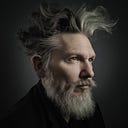Thank you for your insightful feedback, Camille. Your preference for "synthography" resonates, capturing the essence of image synthesizers brilliantly. The term "algography," drawing from "photography" or "writing with light," seeks to illuminate the creative process as a form of "writing with algorithms." This choice emphasizes guiding influence and creative partnership with algorithms rather than exerting strict control over them. Similar to the way photographers manipulate visual elements like aperture, shutter speed, and film sensitivity, and later refine their images through development techniques, algographers set parameters and navigate through the outcomes generated by AI.
The journey of art creation, whether in the realm of photography or algography, involves meticulous planning, envisioning, experimenting, and making choices that shape the final work. It’s about embracing the process and engaging in a collaborative exploration with the technology at hand. My background in photography has paved the way for me to appreciate algography as an exciting evolution in visual storytelling.
Through algography, we are not merely capturing scenes illuminated by light but are bringing to life the images from our imagination, in concert with algorithms. This shift represents a movement from documenting the external world to revealing the internal landscapes of our minds with the aid of generative AI.
Algography merges technology and artistic exploration, charting new paths for creative expression. It's somewhat reminiscent of Stieglitz's efforts to photograph clouds, where the aim was to present something extraordinarily, highlighting the unique blend of personal vision and technological partnership.
In this light, algography is not just about adopting a new medium; it's about embarking on a journey into the vast realms of creativity and imagination, guided by the sophisticated capabilities of algorithms. This process marks a significant evolution in art, inviting us to explore the vast potential of digital creativity and how it can expand our expressive horizons.
